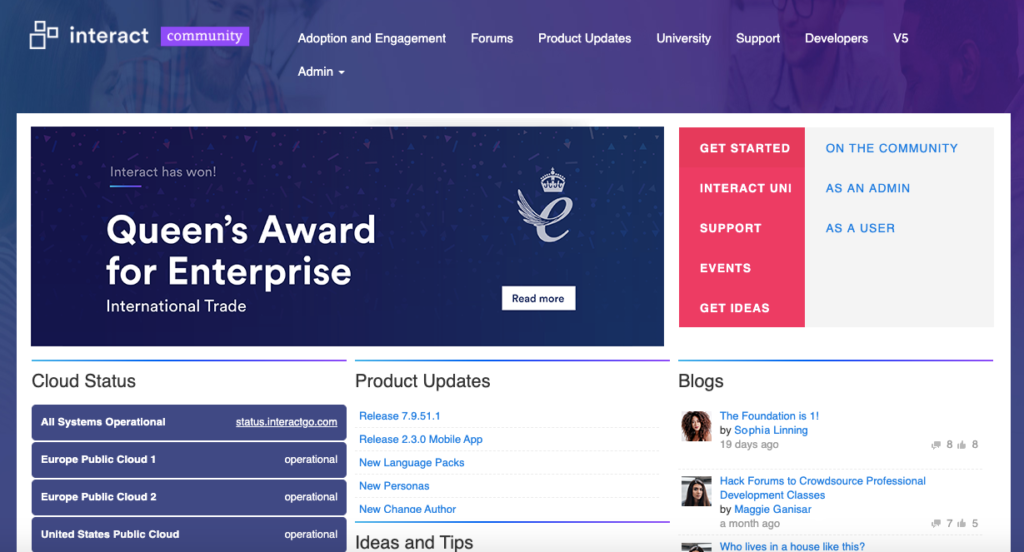Extranets: how to maximize the relationship with your external contacts

“Where intranets embrace employees within a company, extranets extend outwards to offer similar functions to those working closely with the business but separate from it.”
Developments in the digital workplace mean that the way we work with third parties has evolved. As work continues to improve the relationship and experience of customers and employees, there is a much higher expectation of providing a service to your external contacts too. With the help of various technologies, the relationship between the organization and its partners, contractors, suppliers, and vendors gets ever closer.
This strengthening of ties with third parties has massive benefits – and can significantly improve productivity, efficiency, and accuracy. And it’s also becoming an expectation in modern business to be able to receive information on transactions, orders, and tasks from their suppliers, vendors, and partners.
Just as a customer expects to see live tracking for a delivery, businesses expect the same insights into processes that influence their work. Having one point of contact available 24/7, and access to all the latest news, product updates and job statuses is now very much de rigeur. The more information they can glean on a transaction, the better.
This has created a challenge for businesses, who are struggling to find ways to update, share information, and communicate with key parties. How do you provide a service that gives access to some – but not all – of your company’s confidential data?
The answer lies in an extranet. This platform carries similar benefits of an intranet – the collaboration, the connection, and the communication – but with controlled access to third-party contacts.
What is an extranet?

When you need to enable collaboration and information, an extranet provides this in a controlled, private network. With an extranet, you can give access to your workforce as well as external parties – which can include your suppliers, your customers, and contractors.
It can sit within your existing company intranet with the help of limited access and different authentication methods, or it can be on a completely separate platform entirely.
Wherever it is hosted, its purpose is to provide an area where collaboration and communication with the most important people outside of your organization can take place.
Here you can enable richer methods of communication with your external contacts than email can provide. A live page can provide tracking info, product spec, and updates. Users who are invited on to the extranet can then access, download, and share this information as required. And when you have an extranet doing all the work, you can cut out the emails, phone calls, and information requests that have long been an established part of the supply chain.
💡 If you find yourself asking, “what is an extranet?” take a look at our primer on Intranet vs Extranet definitions 💡
Access to information has become embedded within our expectations. With this rise in the need for fast, accurate data, extranets are becoming ubiquitous. In fact, most of us probably use extranets without even realizing it. Logging on to a courier site and tracking the progress of your online orders, or checking the availability of a table on a restaurant’s website are just some of the ways that extranets are part of the fabric of everyday life.
The four main types of extranets

Confused about the myriad of functions of an extranet? It’s easier to understand when you realize there are four main types of extranet:
Employee extranet: This is generally a basic intranet that allows employees to access their time-sheets and general information regarding the requirements of their role. HR also implement extranets into their communication with the workforce, as they allow confidential information to be shared without it being shared with colleagues or managers.
Project extranet: This type of extranet is generally used for project management situations where work crosses over with third parties. For example, the design and build of a housing estate will need communication and understanding from various teams of people, from architects to engineers and contractors. With the possibility of so many users on the task management software, permissions can be granted and limited as required.
Supplier extranet: Most commonly used by e-commerce platforms, supplier extranets can help significantly with logistics. They are essential for anything connected to moving items from supplier to distributor to courier to customer, and in some cases, back again. Information and communication regarding orders and statuses are easily attainable for all parties concerned.
Integration extranet: When a brand sells goods online, an integration extranet records inventory data on products sold and products remaining. This data is for stock-taking purposes and keeps current levels live on the website. Integration extranets can be based upon a business’s CRM or intranet, or on an entirely separate platform.
The benefits of an extranet

So why should you implement an extranet into your range of services? In short, there are a host of benefits that can be enjoyed by both the business and their external contacts. Some of them are as follows:
Extranets enhance knowledge sharing
How do you share information with your clients, vendors, or supplier at the moment? For many organizations, it is through email, which is both unreliable and fragmented. While some emails get lost and deleted, others contain data too large to send. Some emails can get overlooked; others ignored. Basically, in terms of business interactions, emails should be given a wide berth. Through the use of an extranet, all information required is accessible and in one place. Easy search allows you to find older information, and there’s no need to request resends.
Extranets provide safety and security
Extranets are one of the most secure ways of keeping documents and data safe. By providing SSL encryption, you can control access permission, limit user controls, and provide an audit trail. This trail can display the activity of each user, so you can see who accessed what at any time.
Extranets enable collaboration
There’s a wide variety of extranets available some of which, depending on your requirements, can act as easy project management software. With all the information and tools required, users can access it from wherever their location is. Admin can assign and manage tasks, and documents can be uploaded, downloaded, stored, and edited. You can also allow chat to have quick catchups and updates, and contact individuals or teams to ask questions or relay information.
Extranets can provide live data feeds
If you’re using your extranet as collaborative software, there is an obvious requirement for a live data feed. Extranets have the benefits of using real-time data to allow the live tracking of every transaction, order, and delivery of items along the chain. This is essential for organizations who undertake operations with several different parties. The benefits of this include cost savings, greater quality of service, and efficiency in business processes.
There are many more benefits to nurturing a more collaborative working relationship with people outside of your organization. Clients have a huge desire to get the latest update on projects and delivery and up-to-the-minute information. When you’re able to provide this, you not only prove yourself to be accurate and reliable but also make the supply chain run so much more smoothly.
And when problems do occur, you’re able to contact those affected with an up-to-date report. This ability to counter issues immediately streamlines logistics, customer services, support, and any other department affected by delays or issues.
How an extranet can help your organization

Interactions between you and your partners generate a mine of knowledge. Phone calls and emails can determine an incredible amount of information. But if this information is not managed correctly, it can be a massive waste of resources. Information gets lost or misinterpreted, or it remains within the realms of one conversation, unshared with others.

We’ve learned about the value of extranets from our experiences with our own extranet Interact Community. As the business grew, Interact realized the need to be able to communicate with customers and keep them updated on new features and product development. Interact Community was built to house the questions, discussions, and knowledge-sharing that are part of general discussions regarding our product. Our extranet has created a global community that can discuss ideas, get advice, and share best practice.
The Community is an exclusive and secure area, accessed through intranet technology, where customers can get the latest updates, support, ideas, and info on upcoming events.
When customers ask questions, our experienced technical support team offer help and advice. With this service, customers can constantly feel supported and empowered to share ideas and questions.
But what do our customers think?
“Interact is very good at keeping in touch with its customers. The community approach runs deep through the entire product.”
The Community scores well in every survey we run, and we’re proud that it proves essential to so many of our customers. The feedback we receive underlines the value in the variety of ideas, challenges, and range of customers involved. We have businesses in different countries talking with one another, swapping tips and receiving up-to-the-minute information on all developments with Interact software.
Of course, this is useful for our customers, but it’s been invaluable to us. The Community acts as a barometer, a communication portal, a place to beta-test new features and somewhere to troubleshoot issues. Above everything, the Community is also somewhere where we can learn about all the innovative and creative ways that our software is being used. It’s a resource that has definitely provided a rich learning experience for both our customers and us.
Which is what extranets are chiefly about – bring organizations together, sharing knowledge, accessing information, forming more fruitful relationships, and with this, business processes are galvanized as a result.
